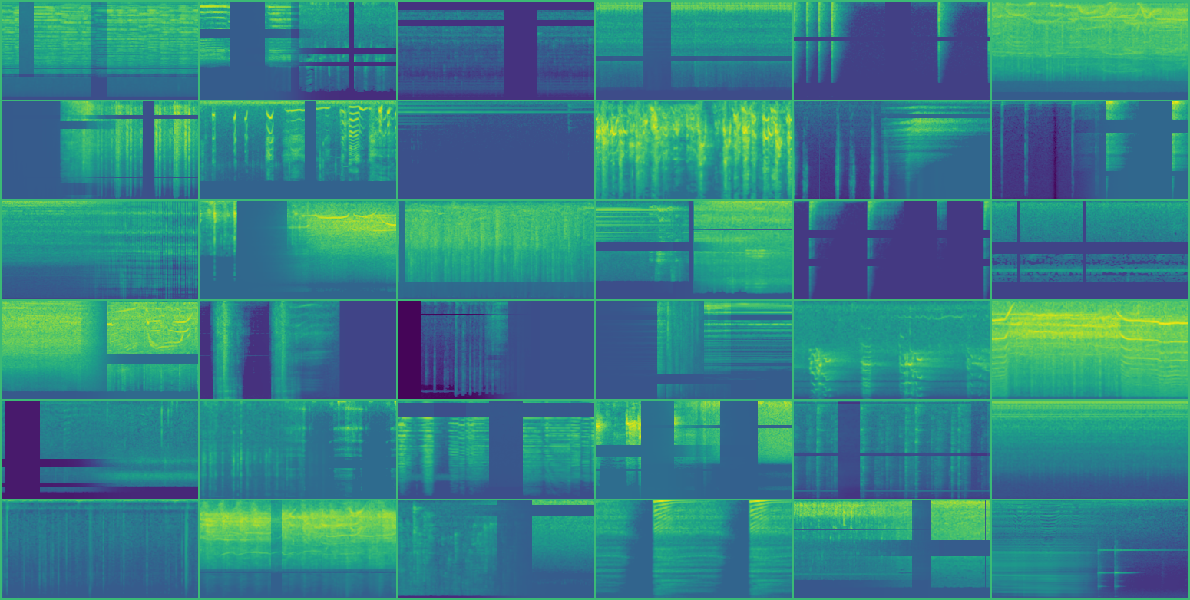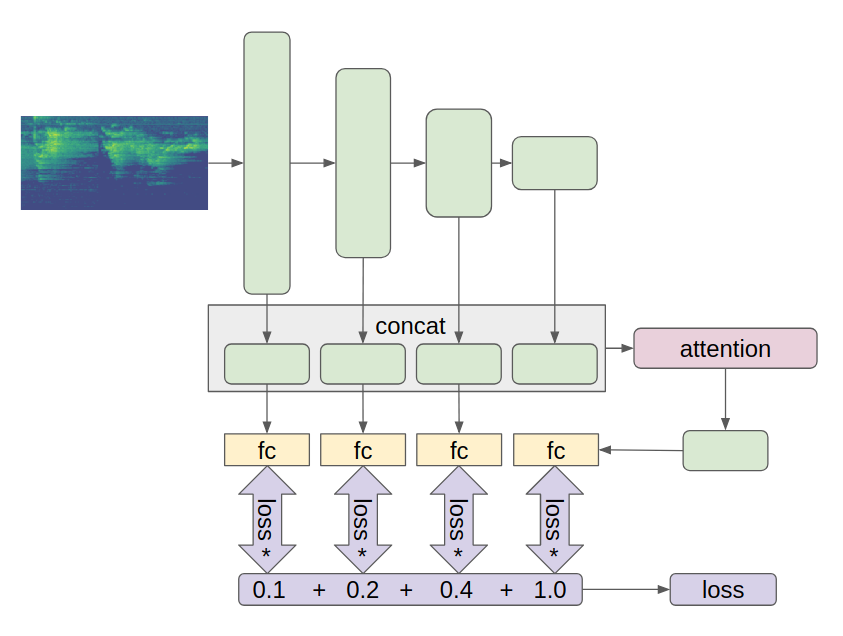This repo contains the source code of the 1st place solution for Freesound Audio Tagging 2019 Challenge. The goal of the competition is to develop an algorithm for automated multi-label audio tagging. The main research problem of this competition is to properly utilize a small amount of reliable, manually-labeled data, and a larger quantity of noisy audio data from the web in a multi-label classification task with a large vocabulary (80 categories).
Key points:
- Log-scaled mel-spectrograms
- CNN model with attention, skip connections and auxiliary classifiers
- SpecAugment, Mixup augmentations
- Hand relabeling of the curated dataset samples with a low score
- Ensembling with an MLP second-level model and a geometric mean blending
The Argus framework for PyTorch was employed. It makes the learning process more straightforward and the code briefer.
Log-scaled mel-spectrograms is the modern standard way of the data representation in CNN-based audio scene classification. Converting audio to spectrograms in this solution was inspired by the daisukelab's data preprocessing notebook. Audio config parameters:
sampling_rate = 44100
hop_length = 345 * 2
fmin = 20
fmax = sampling_rate // 2
n_mels = 128
n_fft = n_mels * 20
min_seconds = 0.5
Several augmentations were applied on spectrograms during the training stage. The part of transforms.py lists augmentation techniques:
size = 256
transforms = Compose([
OneOf([
PadToSize(size, mode='wrap'), # Reapeat small clips
PadToSize(size, mode='constant'), # Pad with a minimum value
], p=[0.5, 0.5]),
RandomCrop(size), # Crop 256 values on time axis
UseWithProb(
# Random resize crop helps a lot, but I can't explain why ¯\_(ツ)_/¯
RandomResizedCrop(scale=(0.8, 1.0), ratio=(1.7, 2.3)),
prob=0.33
),
# SpecAugment [1], masking blocks of frequency channels, and masking blocks of time steps
UseWithProb(SpecAugment(num_mask=2,
freq_masking=0.15,
time_masking=0.20), 0.5),
# Use librosa.feature.delta with order 1 and 2 for creating 2 additional channels
# then divide by 100
ImageToTensor()
])
MixUp [2] augmentation was found to be beneficial in the competition. This method creates a new training sample based on the weighted average of two items from the original dataset. Additionally, SigmoidConcatMixer was applied. It produces a merged sample with a smooth (sigmoid-based) transition from one audio-clip to another over time.
There are some augmented spectrograms, and they look crazy :)

Model from mhiro2's kernel was used as a starting point. After numerous experiments, the original architecture was modified with attention, skip connections, and auxiliary classifiers.
- 5 random folds
- Loss: BCE on curated, Lsoft [3] with beta 0.7 on noisy data
- Optimizer: Adam with initial LR 0.0009
- LR scheduler: Reduce on a plateau with patience 6, factor 0.6
- Use different probabilities for sampling curated and noisy data
- Training on hand relabeled curated samples with a low lwlrap score by previous models
- Training with BCE on noisy samples with a high lwlrap score by previous models
- Mixed precision training with apex.amp allows using batch size 128 with input size 256x128 px
The geometric mean of 7 first-level models and 3 second-level models was used for the final submission. MLPs trained with different hyperparameters were used as second-level models. Seven first-level models were chosen by enumeration of combinations of training experiments to finding the highest CV score.
The progress of the solution during the competition can be seen in the laboratory journal. It describes all the experiments and ideas, but it is partially in Russian, sorry :).
- Linux
- Nvidia drivers, CUDA >= 10.0, cuDNN >= 7
- Docker, nvidia-docker
The provided Dockerfile is supplied to build an image with CUDA support and cuDNN.
- 32GB of RAM
- 2080ti or another GPU with fp16 support and at least 12GB memory
-
Clone the repo, build docker image.
git clone https://github.com/lRomul/argus-freesound.git cd argus-freesound make build -
Download and extract dataset to
datafolderFolder structure should be:
data ├── README.md ├── sample_submission.csv ├── test ├── train_curated ├── train_curated.csv ├── train_noisy └── train_noisy.csv
-
Run docker container
make run
-
Create a file with folds split
python make_folds.py
For example, take the experiment corr_noisy_008, which currently is in the train_folds.py:
-
Train single 5 fold model
python train_folds.py --experiment corr_noisy_008
Model weights will be in
data/experiments/corr_noisy_008 -
Predict train and test, evaluate metrics
python predict_folds.py --experiment corr_noisy_008
Predictions, submission file, and validation metrics will be saved in
data/predictions/corr_noisy_008
If you want to reproduce the whole ensemble, you should train all experiments in stacking_predict.py, script ensemble_pipeline.sh can help:
- Download and extract data.
- Run full pipeline
./ensemble_pipeline.sh
- Kernel code will be saved in
kernel/stacking_kernel_template.py. - Models weights will be saved in
data/experiments. You can zipexperimentsfolder and upload the archive to kaggle dataset.
It was quite challenging to manage the project without a way to split the solution into modules. The idea of kernel building from the first place solution of the Mercari Price Suggestion Challenge was used. You can find the build system template here.
To create a submission, run python build_kernel.py, this would compress the whole project into scripts in the kernel folder:
kernel_template.py- single model submissionstacking_kernel_template.py- ensemble submission
[1] Daniel S. Park, William Chan, Yu Zhang, Chung-Cheng Chiu, Barret Zoph, Ekin D. Cubuk, Quoc V. Le, "SpecAugment: A Simple Data Augmentation Method for Automatic Speech Recognition", arXiv:1904.08779, 2019.
[2] Hongyi Zhang, Moustapha Cisse, Yann N. Dauphin, and David Lopez-Paz, "mixup: Beyondempirical risk minimization", arXiv:1710.09412, 2017.
[3] Eduardo Fonseca, Manoj Plakal, Daniel P. W. Ellis, Frederic Font, Xavier Favory, Xavier Serra, "Learning Sound Event Classifiers from Web Audio with Noisy Labels", arXiv:1901.01189, 2019.

